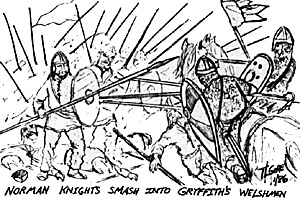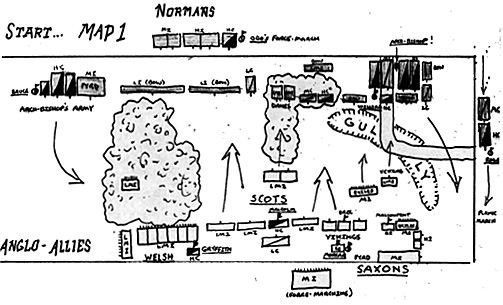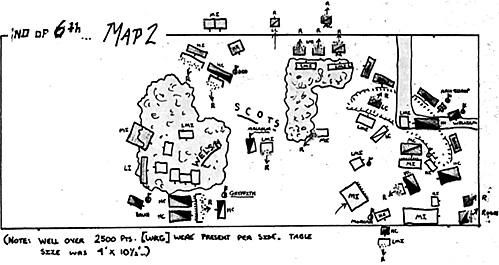 After defeating the Scots and rebellious English at Oxford two
months previously, King William decided to advance north once again
to try to subdue Northumbria. This time, the whole of his army would be involved. The Archbishop marched with him, the Papal sacred banner in the Holy wagon with his eminence. Not only the personage himself, but the entire army of the Archbishop as well. Odo, second in
command of the Norman army, was a half-day behind the main force with his personal troops as well as the Norman infantry when the enemy turned to fight. That morning of September 1st, 1067 changed the course of English history (and our campaign!).
After defeating the Scots and rebellious English at Oxford two
months previously, King William decided to advance north once again
to try to subdue Northumbria. This time, the whole of his army would be involved. The Archbishop marched with him, the Papal sacred banner in the Holy wagon with his eminence. Not only the personage himself, but the entire army of the Archbishop as well. Odo, second in
command of the Norman army, was a half-day behind the main force with his personal troops as well as the Norman infantry when the enemy turned to fight. That morning of September 1st, 1067 changed the course of English history (and our campaign!).
The Anglo-Scots-Welsh-Viking alliance had chosen their field of battle well, On the left (see map) was a large expanse of woods perfectly suited to their mostly LMI army. The center also contained a smaller woods which nicely broke up the Norman army. But the huge gully on the left really made a mess of things for the cavalry heavy Normans. The early morning sun found the allies in position and waiting.
The King, on first seeing the allies tactical situation, decided on a simple plan--the gully would provide an obstacle for the enemy to cross, therefore the vulnerable archers could be placed along it's edge and not be in as much danger as elsewhere, but their fields of fire would be confined. To make the best use of their firepower, an all-out cavalry sweep would be made around the English flank. Rogor would flank-march (off the table) with his Norman knights past the gully and strike into the rear units of the Saxon infantry, William's knightg would attack frontally across the gully roads from both directions to tie up the Vikings while the majority of the cavalry would movir around the left flank of the gully and sweep through the enemy center, The medium cavalVy units (retainers) were placed in the central woods to confuse the enemy and also to have a force placed past the gully to attack any flank offerings the enemy made if moving in toward the archers.
Confusion and disagreement with the Archbishop forced the King to acquiesce to the Archbishop's desire to send all his troops around the extreme right hand flank, to try and take the Welsh in the rear. This left the center poorly held. Only the LMI Danish mercenariest bolstered by Galwegian deserters and a small LC unit of Bretons were placed to deny the small central woods to the enemy.
William was counting (too much) on the forces with Odo who were forces marching to join the battle to appear in time to shore up the center and hold off any enemy thrusts to split the Normans. This then was the basic plan. The Archbishop, deciding that he felt safer with the Normans than with his own men (!), placed his banner and wagon in the center of William's forces on the left leaving a sub-general to actually lead his own troops. (See Map 1)
The Vikings and Scots each force-marched some troops the 1st period and were quickly at the center of the battlefield, taking slight losses. William began his flank march, but the overly excitable A class knights charged full-tilt across the bridge smashing head-long into the force marched Viking berserkers. Both units were in wedge, but the deadly lances and impetuous charge proved too much for fhe hapless berserkers who routed.
Trying to exploit this sudden unexpected success proved futile for William. He had kept a unit of Breton mixed HC and MC in reserve, so he threw them across the bridge also to try and follow up the Norman Household Knights' success, Unfortunately, held moved another Norman cavalry unit to the left hand bridge to hold it and, as usual, they too, on seeing enemy in eight went impetuous and charged across the bridge, both cavalry unita running into each other~and becoming disordered, their attacks bogging down.
In the center, the Danish sub-commander (See SAGA, vol,1, Dave Sweet's report on this) tried in vain to frustrate the Scottish army descending in it's entirety on his two small units, His right hand supporting Breton LC took one look at the massive blocks of fanatical Scots charging down and routed. The two MC units that William had posted in the woods emerged only to find that they were stuck, unable to turn a flank to the force-marched Galwegians so they valiantly attempted to charge. One unit went in and was quickly sent in rout back to the woods as the deadly two-handed axes of the enemy did their work. The other, stunned by their exposed position and routing supports, were attacked by the crazed and impetuous Scots and were quickly joining their comrades in a mad dash through the woods.
The Danes fought bravely and dealt the Scots a blow by routing one of their units, but the numbers told their tale and they too were soon routing as well. The Archbishop's flank cavalry had slipped around the large Welsh infested woods and taken the Welsh rear guard, who were in the open, in a wild charge, routing them and their general, Gryffith, who had somehow gotten himself and his bodyguard placed directly behind the infantry! The Archbishop's fyrd slogged into the woods and soon learned how bad it was to be disordred and facing seven or so fresh units of LMI!
Meanwhile, back on the Norman flank, Roger's forces had come on board, after making a long flank march and immediatly without waiting for any support (good old Norman cavalry) charged straight into the Saxon fyrd and Huscarles guarding the English flank. Just as suddenly Roger and his knights were thrown back in rout! Another unit of mercenary French Knights smashed into a second Saxon Huscarle unit and routed themi The center was becoming an utter chaotic mess, with swirling groups of routers, counter-chargers, disordred melees, flank charges and general mayhem, William saw his problem early -- he didn't have enough fresh units to keep up the pressure, he was out of supporting units. Helplessly he watched his precious cavalry, the knighthood of Europe, become fragmented and hit again and again by fresh Viking, Scots and English troops. Roger had fled the battle in rout with his troops, Guy's Normans fought for their lives as the traitor Morear led his exiles in a rear assault on them, the axes doing awful slaughter and yet the knights held, turned to face and were again hit in the rear, this time by a large unit of late arriving Scots... still they held!
In the distance, a flurry of banners, the Norman Household cavalry who had routed the Viking berserkers had ceased their pursuit, rallied (after pursuing and being pursued off the table) and were in the enemy rear as well as the Archbidhop's cavalry swinging through from the right in pursuit of the fleeing Welsh. Odo's forces, ravaged by force-marching (HI do not do well under WRG 6th edition force-marching rules), finally arrived and put a halt to the Norman allies routs in the center.
But it was all in vain. The hapless archers, solidly defending their side of the gully had been outflanked by the Galwegiana, who, screaming their battle cries, surged forward to destroy these ill-armed men, William had nothing left to defend them with except the Archbishop's bodyguard of exiled English deserters! They formed up and awaited the inevitable. They would expect no quarter, they were dead men.
William saw but one chance to win left. Putting spurs to his charger, he and his personal retinue along with the now recovered Roger and his knights tried to bludgeon through the shored up Saxon Huscarles, Vikings and Scots, trying to join with the Archbishop's cavalry who now were only two moves away. If they could break through, their combined forces would be able (with the newly arrived troops of Odo) to at least insure that the battle would not be lost. Morcar, hatred in his heart and triumph in his grasp, the throne of England his Holy Grail, ordered an all out counter-charge by his remaining troops. The once proud Huscarles, reduced to half their former strength, the ragged fyrd, goaded on by promises of knight's bodies to plunder, the ever blood-thirsty Vikings, tasting the blood of victory, all these and more poured into the advancing thin line of Norman knights.
The archers, attacked on two sides (the Vikings charged across the gully, the Galwegians from the flank) didn't have a chance. They folded up and in their rout carried their friends with them. The Archbishop, suddenly alone with his handful of axemen was struck by the Viking wedges and broke, his Papal banner captured, his men cut down, himself thrown in chains, his fate uncertain in the hands of the savage Norse/Saxons.
Deprived of his archer support fire, William was in deep trouble. Outnumbered, outflanked, and outfought, his last charge was a warrior's testiment to human courage. The lances and battle-axes closed, the dust embroiled the combatants, the cries of the wounded and dieing fill- ed the evening air... it was all over. The Norman remnants streamed to the rear (the English CiC rolled two +4s and a +3. William fell from his mount, hacked and pierced by innumerable weapons, dying in the twilight as Morcar contemptuously,stripped his body of the riches of the realm.
With the destruction of the main army, Odo saw that all was lost and withdrew his army in good order. The Archbishop's troops, seeing their sacred banner in Viking hands knew all was lost. Given a choice of becoming hunted fugitives or bowing to God's will, they halted and parlayed for peace with the victotious allies. Nightfall found the field a cold sculpture of death. There was a new King of England that night and all history would be changed.
Maps


Aftermath of The Battle of Lincoln 1067 A.D.
Back to Saga # 2 Table of Contents
Back to Saga List of Issues
Back to MagWeb Master Magazine List
© Copyright 1986 by Terry Gore
This article appears in MagWeb (Magazine Web) on the Internet World Wide Web. Other military history articles and gaming articles are available at http://www.magweb.com